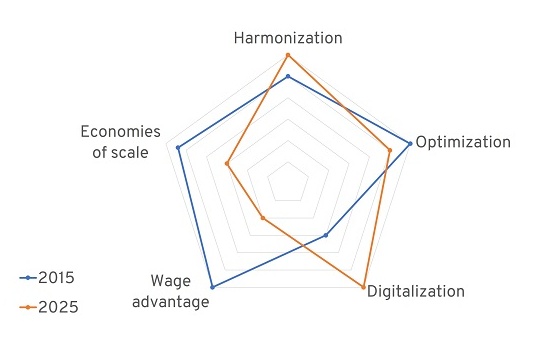Shared services for Finance 4.0 or the end of this form of organization?
Shared services were introduced 20 years ago to optimize costs. This was achieved primarily by
- taking advantage of labor benefits in low-wage countries as well as
- achieving economies of scale by bundling transactional processes in particular.
With increasing digitalization, the following thesis could be put forward:
Shared services will no longer be needed in the future, as most "rule-based" activities will be mapped via self-service, process digitization (e.g., chat bots, RPA, etc.), and other digital solutions, and thus the use of wage advantages and the achievement of economies of scale will decrease significantly.
Shared services can support digitalization
This thesis is basically correct, but there are additional aspects to consider when looking at shared services. Especially against the background of ubiquitous digitalization, it is necessary to consider the following aspects as well:
- Standardization/ harmonization of processes
Standardization and harmonization across all units, countries/locations and business units (BUs) is the basis for efficient digitalization. Without a clear, uniform definition/implementation of terms, concepts and processes, it is not possible to standardize and digitize. The shared service organization remains one of the key enablers here. - Optimization of the services to be provided
Charging for services on the basis of their causation supports transparency vis-à-vis the service recipient and thus helps to optimize service consumption. This can only be achieved with the consistent implementation of service concepts and their digital processing, which is generally best achieved by shared service organizations.
→ Digitalization of processes and workflows
The uniform use of technologies and solutions in a shared service organization can optimize development and operating costs. This means that companies are well equipped for future challenges and can face the changes in the market.
Advantages of integrating shared services into the organization
The need to arrive at clear definitions within the entire company when digitalizing complements those responsible in a shared service organization. Both support the company in making clear decisions and adequately addressing issues such as compliance.
Most companies operate shared service organizations - but in different setups and levels of maturity. As is often the case, there is no universal solution. However, it is essential to adapt the approach to the business strategy, the current corporate structures and management (country structure, organizational structure, strategy for BUs (dependent vs. independent), etc.), and the culture of the company.
Our outlook for Shared Service Organization 4.0

We are convinced that there are still very good arguments in favor of shared service organizations, even if their characteristics will continue to change.
Essentially, a Shared Service Organization 4.0 can look as follows:
- Employees have excellent technological skills and digital competence.
- Work in agile teams to respond easily to changes.
- Service portfolio is expanded with increasingly complex activities and supported by digital solutions (e.g., analytics to provide business metrics).
- Reduction in size for Centers of Scale (with more transaction-based activities).
- Increase in Centers of Expertise/Competence with specialized services.
- Strong focus on service orientation and service culture for demand-oriented service delivery.
Contact
With our holistic approach and our experts from different disciplines, we help you to shape and successfully implement your transformation. We help you to see the big picture, but also to take the right next small steps. Often small changes already have a big impact.
Feel free to contact our Trusted Advisors today. We look forward to talking with you.
![[Translate to English:]](/fileadmin/_processed_/3/d/csm_AdobeStock_278455821_85db6e8108.jpeg)

